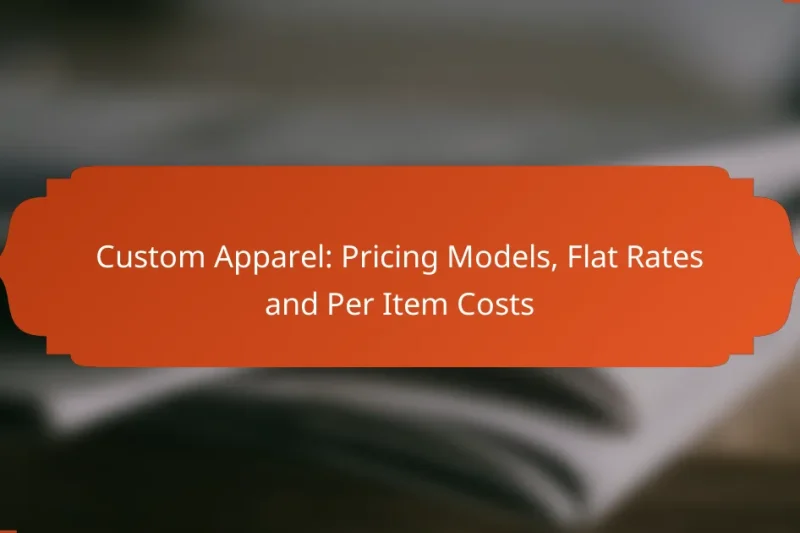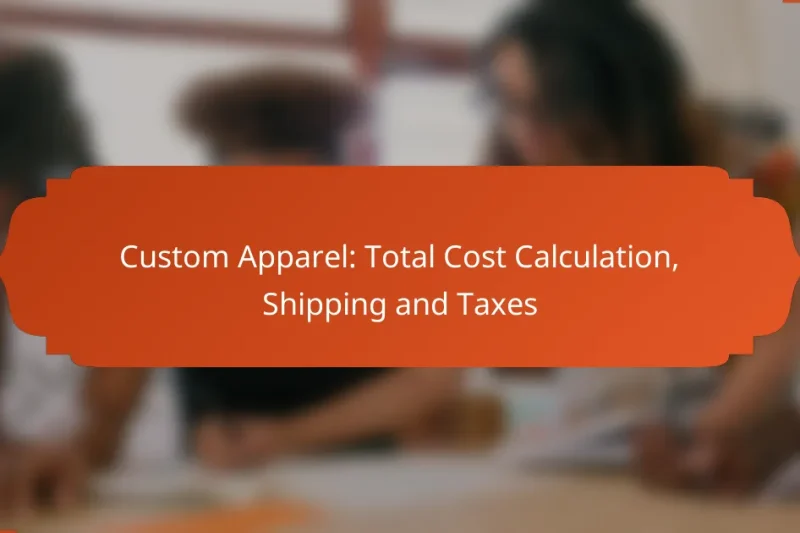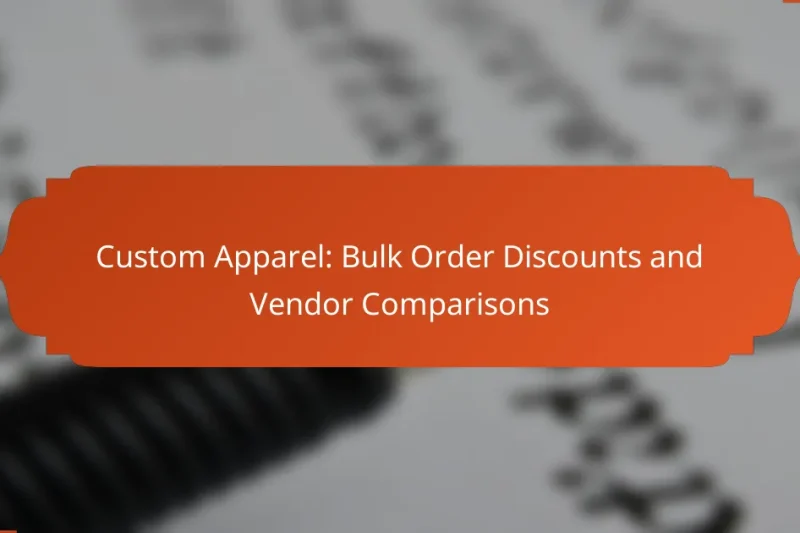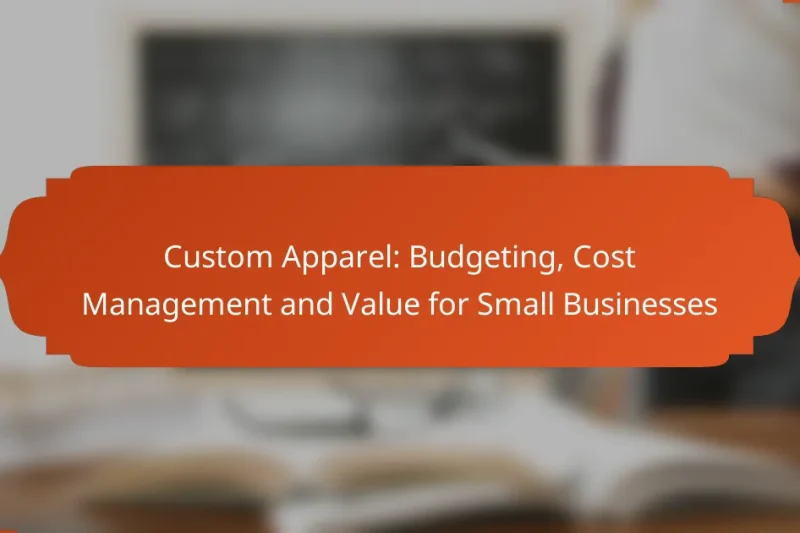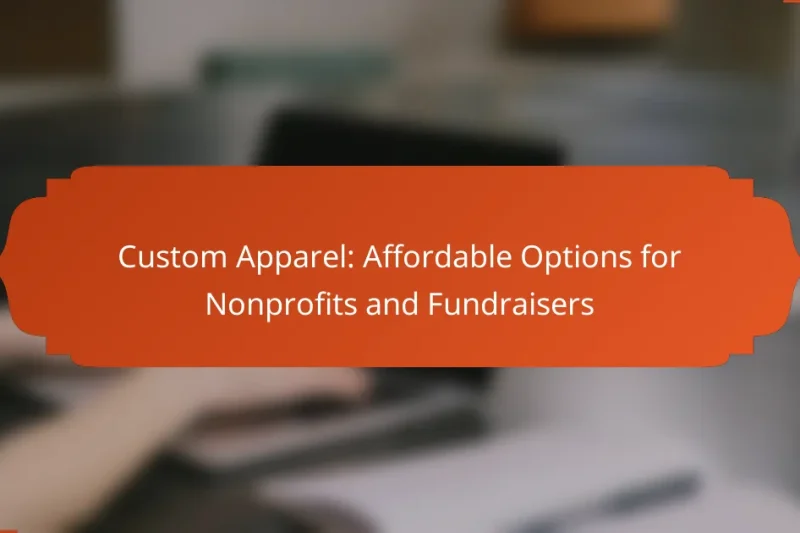Custom apparel pricing models offer a range of options, including flat rates and per item costs, … Custom Apparel: Pricing Models, Flat Rates and Per Item CostsRead more
Pricing Strategies for Custom Apparel
Pricing strategies for custom apparel play a crucial role in balancing profitability and customer attraction. By exploring methods such as cost-plus, value-based, and competitive pricing, businesses can tailor their approach to meet market demands and production costs. Key factors like material quality, design complexity, and order volume further influence effective pricing decisions.
Custom Apparel: Total Cost Calculation, Shipping and Taxes
Calculating the total cost for custom apparel involves several key components, including the base price, design … Custom Apparel: Total Cost Calculation, Shipping and TaxesRead more
Custom Apparel: Cost, Quality and Prioritization Strategies
Custom apparel offers a unique opportunity for personalization, but its costs can vary widely depending on … Custom Apparel: Cost, Quality and Prioritization StrategiesRead more
Custom Apparel: Bulk Order Discounts and Vendor Comparisons
When ordering custom apparel in bulk, it’s essential to choose a vendor that provides competitive pricing, … Custom Apparel: Bulk Order Discounts and Vendor ComparisonsRead more
Custom Apparel: Budgeting, Cost Management and Value for Small Businesses
Budgeting for custom apparel is essential for small businesses, as it involves estimating costs for materials, … Custom Apparel: Budgeting, Cost Management and Value for Small BusinessesRead more
Custom Apparel: Seasonal Sales Impact on Pricing
Seasonal sales play a crucial role in shaping the pricing of custom apparel, as they create … Custom Apparel: Seasonal Sales Impact on PricingRead more
Custom Apparel: Affordable Options for Nonprofits and Fundraisers
Custom apparel offers an affordable way for nonprofits and fundraisers to create branded merchandise that enhances … Custom Apparel: Affordable Options for Nonprofits and FundraisersRead more
What are effective pricing strategies for custom apparel?
Effective pricing strategies for custom apparel include cost-plus pricing, value-based pricing, and competitive pricing. Each approach has its own advantages and considerations, allowing businesses to align their pricing with costs, perceived value, or market conditions.
Cost-plus pricing
Cost-plus pricing involves calculating the total cost of producing an item and adding a markup to determine the selling price. This method ensures that all production costs, including materials, labor, and overhead, are covered while providing a profit margin, typically ranging from 20% to 50% depending on the market.
To implement cost-plus pricing, first, accurately assess all costs involved in creating the custom apparel. Then, decide on a suitable markup percentage based on industry standards and your business goals. Be cautious of potential pitfalls, such as underestimating costs or failing to adjust prices in response to market changes.
Value-based pricing
Value-based pricing sets prices based on the perceived value of the custom apparel to the customer rather than solely on production costs. This strategy can yield higher profit margins, especially if the apparel offers unique features or benefits that resonate with the target audience.
To effectively utilize value-based pricing, conduct market research to understand customer preferences and willingness to pay. Highlight the unique selling points of your apparel, such as sustainability or customization options, to justify higher prices. Avoid undervaluing your product by focusing too much on competitors’ pricing instead of the value you provide.
Competitive pricing
Competitive pricing involves setting prices based on the prices of similar products offered by competitors. This strategy is particularly useful in saturated markets where customers can easily compare options, ensuring your pricing remains attractive.
To adopt competitive pricing, regularly analyze competitor pricing and adjust your prices accordingly. Consider offering promotions or bundling products to enhance perceived value without compromising your profit margins. Be mindful of the risk of price wars, which can erode profitability if not managed carefully.
How to determine the right price for custom apparel?
Determining the right price for custom apparel involves assessing production costs, understanding market demand, and identifying your target audience. A well-calibrated price not only covers expenses but also attracts customers while ensuring profitability.
Calculate production costs
To set a price for custom apparel, start by calculating all production costs. This includes materials, labor, overhead, and any additional expenses such as shipping or packaging. For example, if a t-shirt costs $5 in materials and $3 in labor, your base production cost is $8.
Consider adding a margin for unexpected costs, which can typically range from 10% to 30%. This ensures that you remain profitable even if expenses fluctuate. Keep detailed records of all costs to refine your pricing strategy over time.
Analyze market demand
Understanding market demand is crucial for pricing custom apparel effectively. Research competitors’ prices and identify trends in consumer preferences. If similar products are priced between $20 and $30, positioning your apparel within this range can help attract buyers.
Utilize surveys or social media polls to gauge interest in specific designs or styles. This feedback can inform your pricing strategy and help you adjust based on what customers are willing to pay.
Consider target audience
Your target audience significantly influences pricing decisions. Identify who your customers are, their purchasing power, and what they value in custom apparel. For instance, if your audience consists of college students, a price point around $15 to $25 may be more appealing.
Tailor your marketing and pricing strategies to resonate with your audience’s preferences. Offering discounts or loyalty programs can also enhance perceived value and encourage repeat purchases, making your pricing strategy more effective.
What factors influence custom apparel pricing?
Custom apparel pricing is influenced by several key factors, including material quality, design complexity, and order volume. Understanding these elements can help businesses set competitive prices while ensuring profitability.
Material quality
The quality of materials used in custom apparel significantly impacts pricing. Higher-quality fabrics, such as organic cotton or moisture-wicking blends, typically cost more than standard options. Businesses should consider the balance between quality and cost to meet customer expectations without sacrificing profit margins.
For example, a t-shirt made from premium fabric may range from $15 to $30, while one made from basic cotton might be priced between $8 and $15. Offering a variety of material options can cater to different customer budgets.
Design complexity
Design complexity plays a crucial role in determining the final price of custom apparel. Intricate designs that require advanced printing techniques or multiple colors can increase production costs. Simple designs, on the other hand, are generally more cost-effective to produce.
For instance, a basic logo printed on a shirt may add $2 to $5 to the base price, while a full-color graphic could increase the cost by $10 or more. It’s essential to communicate design options clearly to customers to manage their expectations regarding pricing.
Order volume
Order volume can significantly affect pricing strategies for custom apparel. Larger orders often qualify for bulk discounts, reducing the per-unit cost. Conversely, smaller orders may incur higher prices due to fixed setup costs associated with production.
For example, an order of 100 shirts might cost $10 each, while an order of 10 shirts could be priced at $15 each. Businesses should evaluate their pricing structure to incentivize larger orders while remaining competitive for smaller requests.
How to implement discounts and promotions for custom apparel?
Implementing discounts and promotions for custom apparel can effectively attract customers and boost sales. Consider seasonal offers, bulk order incentives, and loyalty programs to create compelling value for your clientele.
Seasonal discounts
Seasonal discounts are time-limited offers that coincide with holidays or specific times of the year. For example, you might offer a 15-30% discount during back-to-school season or around major holidays like Christmas. These promotions can help clear inventory and encourage purchases during peak shopping periods.
When planning seasonal discounts, ensure your marketing materials highlight the limited-time nature of the offer. This urgency can motivate customers to make quicker purchasing decisions.
Bulk order incentives
Bulk order incentives encourage customers to purchase larger quantities by offering discounts based on volume. For instance, you could provide a 10% discount for orders over 50 items and 20% for orders exceeding 100 items. This strategy not only increases sales but also helps in reducing production costs per unit.
Make sure to clearly communicate the bulk pricing structure on your website and in promotional materials. This transparency helps customers understand the savings they can achieve by ordering more.
Loyalty programs
Loyalty programs reward repeat customers, fostering long-term relationships and encouraging future purchases. You might implement a points system where customers earn points for every dollar spent, which can be redeemed for discounts or free items later. This not only incentivizes repeat business but also enhances customer satisfaction.
To maximize the effectiveness of your loyalty program, promote it through email newsletters and social media. Regular updates about points and rewards can keep your brand top-of-mind for customers, leading to increased engagement and sales.
What are the pricing models for custom apparel e-commerce?
Custom apparel e-commerce utilizes various pricing models to attract customers and maximize profits. The most common models include subscription-based pricing and freemium models, each offering unique advantages and challenges for businesses.
Subscription-based pricing
Subscription-based pricing involves charging customers a recurring fee for access to custom apparel products or services. This model can create a steady revenue stream and foster customer loyalty, as subscribers often receive exclusive designs or discounts.
When implementing this model, consider offering different tiers based on frequency of deliveries or product variety. For example, a monthly subscription could range from $20 to $50, depending on the number of items included. Ensure that the value provided justifies the cost to retain subscribers.
Freemium models
Freemium models allow customers to access basic custom apparel services for free while offering premium features or products at a cost. This approach can attract a larger audience, as users can try the service without any initial investment.
To effectively use a freemium model, clearly define what is included for free and what requires payment. For instance, basic designs might be free, while customizations or premium fabrics could be offered for a fee. Monitor conversion rates from free users to paying customers to evaluate the model’s effectiveness.
